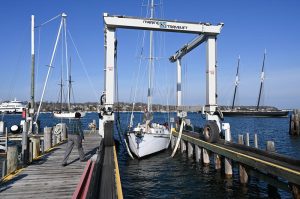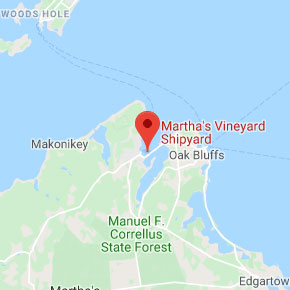Shipyard Expansion Project Clears Early Review With State
Written By: shane on December 11, 2019 A major expansion and redevelopment project at the Martha’s Vineyard Shipyard in Vineyard Haven has cleared a key early hurdle with the Massachusetts Environmental Policy Act (MEPA), which determined that the project does not need a broad environmental impact report.
A major expansion and redevelopment project at the Martha’s Vineyard Shipyard in Vineyard Haven has cleared a key early hurdle with the Massachusetts Environmental Policy Act (MEPA), which determined that the project does not need a broad environmental impact report.
The MEPA certificate, issued last Friday by state Secretary of Energy and Environmental Affairs Kathleen Theoharides, effectively hands off environmental review for the project to the Martha’s Vineyard Commission and other state and local permitting agencies.
“The [environmental notification form] has adequately described and analyzed the project and its alternatives, and assessed its potential environmental impacts and mitigation measures,” the signed certificate states. “Based on review of the ENF and comments received on it, and in consultation with state agencies, I have determined that an [environmental impact report] is not required.”
Earlier this year, the shipyard submitted a notification form to MEPA for the project, which proposes substantial shorefront modifications to support the construction of a 48-slip marina within Lagoon Pond in Vineyard Haven. The project includes the installation of a 5,000 square-foot floating dock system, nearly 5,000 cubic square feet of dredging and increasing the depth of the area’s current navigation channel.
According to Erin Flaherty, the MEPA agent assigned to the shipyard project, the review allows agencies and stakeholders to comment on the project before permitting begins.
A site visit took place last month.
The project is already seeing pushback from Island shellfishermen and others.
Prompted by rising sea levels and increasingly aggressive storm surges, the project also proposes upland work consisting of the removal of two large warehouse buildings and the construction of a new, smaller building as well as a formal parking area on the shipyard’s nearly-four acre parcel off Beach Road. Runoff from impervious surfaces would be directed to water-permeable areas, with most of the property regraded at least 18 inches higher above sea-level.
According to the ENF, the project would affect a small section of coastal beach, 30,000 square feet of land subject to water flow from coastal storms, as well as 70,000 square feet of underwater land containing shellfish. As mitigation, the shipyard has proposed contributing $2,500 to the shellfish seeding fund, raking the project area and relocating shellfish before construction, adherence to the coastal zone management’s guidelines, and prohibition of overnight occupancy of boats at the marina.
“These mitigation measures will be further developed during the permitting process,” the MEPA certificate states.
The MEPA review, which includes a public comment period, drew a large volume of comments from shellfish groups and concerned residents on the Island who are opposing the development.
The board of the Martha’s Vineyard Shellfish Group, a nonprofit group which runs two hatcheries on Lagoon Pond, wrote a letter expressing concern about potential pollution from increased boating in the pond and arguing that the shipyard’s shellfish survey was insufficient. The shellfish group also said there is evidence that the area is a critical nursery ground for channeled whelks, a $6 million Island industry, and that the project could threaten the comeback of a potentially lucrative shellfishing industry in the pond.
“The board fears that adding more stress and pollutants to this already fragile system could take it beyond its tipping point,” the letter says in part.
The Tisbury shellfish department, bay scallopers who have permits on the pond, town residents, and the Martha’s Vineyard Fishermen’s Preservation Trust also sent letters, citing concerns from shellfishermen who depend on the pond for their livelihood. And the state Division of Marine Fisheries said in a letter that many of the mitigation proposals are insufficient, noting that the project will result in a downgrade of the shellfish harvesting classification and could result in the closure of shellfishing acreage.
Other state and local agencies also commented on the project, including the Department of Environmental Protection, the Office of Coastal Zone Management, the Division of Conservation and Recreation and the Martha’s Vineyard Commission.
The state also received numerous letters of support from residents who said they favor economic vitality on the working waterfront in Vineyard Haven.
In their analysis, MEPA officials determined that local and state permitting agencies could capably handle a comprehensive review of the project. “I have received comments from residents who support the project and the increased boating facilities it will provide to residents. I have also received numerous comments from the members of the community which identify concerns that the project may reduce access to recreational and commercial fisheries and introduce in-water pollution sources from increased boating activity,” Secretary Theoharides wrote. “The proponent should continue to work with state agencies during the permitting process to reduce impacts to shellfish resources.”
In response to concerns from CZM, she encouraged the shipyard to relocate its dock system to maintain a 15-foot wide channel with a minimum depth of four feet. She also noted that additional measures would need to be in place to restrict overnight boat occupancy.
The report also noted the project’s benefits, and the immediate necessity for waterfront businesses to adapt to the threats of a changing climate.
“The project will result in decreased flooding at the site,” the secretary wrote. “It is an example of how business owners are responding to the effects of climate change, such as sea level rise and more powerful storms.”
The project will need a Chapter 91 license and water quality certification from the state Department of Environmental Protection, as well as approval from the Martha’s Vineyard Commission, an order of conditions from the Tisbury conservation commission, and a permit from the U.S. Army Corps of Engineers. It may also be subject to review by CZM.
from the Vineyard Gazette




